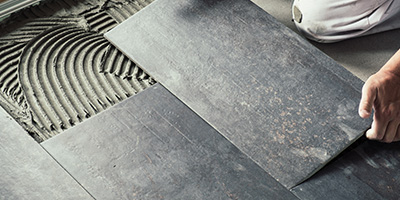Costs Tile Installation Austin Solutions for Your House
Wiki Article
Discover the Tricks to Perfect Ceramic Tile Installment Every Time
Mastering the art of tile setup entails a collection of exact actions and techniques that, when performed correctly, can result in a seamless and polished finish. By understanding the keys behind each action, you can guarantee that your floor tile installation not just satisfies but surpasses your assumptions.
Proper Surface Prep Work
Efficient ceramic tile installment pivots substantially on precise surface area prep work to ensure a remarkable outcome. Before laying ceramic tiles, it is necessary to evaluate the substratum's problem completely. The surface area should be clean, completely dry, and structurally sound to avoid future concerns such as loose ceramic tiles or cracked grout. Any existing floor covering material, adhesives, or sealers must be gotten rid of to produce a consistent base for the brand-new floor tiles.To ensure appropriate attachment, it is suggested to roughen smooth surface areas through sanding or scarifying. Furthermore, using a guide can improve bonding between the substrate and the ceramic tile adhesive. Uneven surface areas need to be leveled making use of a self-leveling compound to prevent lippage and make sure a smooth coating.
Furthermore, looking for possible resources of wetness is essential, as excess moisture can cause mold growth and damages the ceramic tiles gradually. Utilizing a moisture barrier or waterproofing membrane in damp locations like shower rooms or kitchens is necessary to safeguard the tiles from water damages. By meticulously preparing the surface area before tile setup, one can develop a visually enticing and resilient tiled location that will certainly stand the examination of time.

Selecting the Right Adhesive
Picking the suitable adhesive is a critical step in ensuring the successful installment of floor tiles. The sort of sticky you select will certainly rely on different variables such as the kind of floor tile, the substrate product, and the place of the setup. There are various kinds of adhesives available out there, including thin-set mortar, mastic, and epoxy.
Epoxy adhesives are waterproof and exceptionally long lasting, making them ideal for areas vulnerable to moisture such as restrooms or kitchen areas. They are likewise ideal for installing glass or metal ceramic tiles. When choosing an adhesive, see to it to comply with the maker's recommendations and take into consideration the details needs of your tile setup task.
Accuracy Cutting Methods
One of the most typical tools made use of for precision cutting in tile installation is the tile cutter. Ceramic tile cutters come in different kinds, including hand-operated ceramic tile useful site cutters, electrical wet saws, and portable ceramic tile cutters. Hand-operated floor tile cutters are ideal for straight cuts on ceramic and porcelain tiles, giving tidy and precise edges.In addition, making use of devices like ceramic tile scribes or glass cutters can assist in scoring and breaking floor tiles with accuracy. By grasping these precision reducing strategies, ceramic tile installers can make sure a specialist surface and a visually enticing result in their tile tasks.

Cement Application Tips
When transitioning from accuracy cutting strategies to grout application in ceramic tile installment, focus to information and method is extremely important for achieving a remarkable finish. Cement serves not only as a functional element that fills the gaps between floor tiles but additionally plays a substantial role in the overall aesthetic of the setup. To make sure an effective cement application, start by picking the suitable kind and color of grout that complements the ceramic tiles. Mix the grout according to the maker's guidelines, ensuring a lump-free and smooth consistency.Once the grout is applied, utilize a damp sponge to cleanse the floor tiles, making sure not to eliminate cement from the joints. Adhering to these published here grout application tips will result in a professionally set up ceramic tile surface that improves the beauty of any kind of area.
Ending Up Touches and Upkeep
To complete the floor tile installation job properly, interest to detail during the completing touches and routine maintenance is critical. After the cement has actually dried and the tiles are safely in position, the final actions involve ensuring that all sides are appropriately sealed. Using a high-grade sealer around the perimeter of the tiled location assists stop water damage and extends the life of the installation. In addition, looking for any kind of loose floor tiles or grout and addressing them quickly can avoid much more substantial problems down the line.Routine upkeep is key to maintaining the elegance and capability of your tiled surfaces. A simple routine of sweeping or vacuuming complied with by mopping with a mild cleanser can aid maintain your ceramic tiles looking pristine (tile installation austin). For locations that are often revealed to wetness, such as shower rooms or cooking visit the site areas, regular resealing of cement lines is recommended to avoid mold and mildew and mold growth
Conclusion
To conclude, attaining excellent tile setup each time calls for interest to information and correct techniques. By concentrating on surface area prep work, choosing the right adhesive, using precision reducing techniques, applying cement meticulously, and do with interest to detail, you can guarantee a professional-looking result. Remember to follow these actions and keep your floor tiles consistently to lengthen their life-span and maintain them looking their finest.One of the most typical tools utilized for precision cutting in ceramic tile installment is the tile cutter. Tile cutters come in numerous kinds, consisting of manual floor tile cutters, electrical damp saws, and portable tile cutters. Manual floor tile cutters are ideal for straight cuts on ceramic and porcelain tiles, providing accurate and tidy edges. Additionally, making use of devices like ceramic tile scribes or glass cutters can help in scoring and breaking floor tiles with accuracy. By grasping these precision reducing techniques, tile installers can make sure a specialist coating and an aesthetically attractive outcome in their floor tile jobs.
Report this wiki page